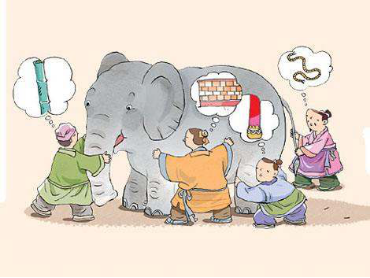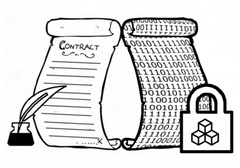The Metaverse and "Blind Man Touching the Elephant"
In the 22nd century, there is a fable circulating in the digital world:
There are five natural people born in the 20th century, who don't know what the metaverse looks like, and they decide to explore the metaverse.
The first person, Neil, came across an open source framework and said, "The Metaverse is about writing science fiction stories together."
The second person, Zha, found that he could scold employees without going to the office. He said, "The Metaverse is a virtual office in VR."
The third person is Huang. This geek saw the machine at a glance and was very happy: "The Metaverse is the GPU\CPU hardware combination."
The fourth person is called David. Seeing that many people use labor as entertainment, he is too excited: "The Metaverse is a big game."
The fifth person is called V. He is a programmer. He said very calmly: "The Metaverse is the blockchain."
The metaverse is a bit like a blind man touching an elephant: everyone has their own perspective, or in other words, everyone only wants the metaverse in their hearts.
This cannot be entirely blamed on the natural person in the 21st century. Because the Metaverse integrates too many technologies such as virtual reality, 5G, web3.0, AI, cloud computing power, big data, blockchain and so on, the natural person in the game will naturally A little dazzling.
It is also a cutting-edge science, which will inevitably lead to cross-interaction of mathematics, cryptography, informatics, life sciences (brain-computer interface), blockchain, quantum computing and other disciplines. It is normal for people to be a little vague.
Then, if you had to choose one of these five people, and said that the elephant he touched was the most accurate, who would you choose?

The metauniverse is undoubtedly the beginning of another form of human life, and it is also one of the choices outside the atomic world. But mathematics can protect the contract. With the explosion of computing power, mathematics may also destroy or even manipulate the contract, so forget about the honest world. Humans will bring all their desires, dreams, good and evil, and civilized memories to the new world, at least at the beginning of the transformation of life forms and nature, This will be a long time.
Is blockchain a "creation stone"?
Before 2021, the technology about the creation of the metaverse is well prepared.
The most dominant VR/AR technology has been around since 2016.
But why, no one thought of the "metaverse" at that time?
An important reason for this is the lack of a "magnetic crystal" that combines other technologies.
The metaverse is hot today because some pioneers think they have discovered the astronomical stone of the metaverse, the blockchain, which can connect all technologies.
From this point of view, the fifth guy named V has the clearest understanding of the metaverse.
Is the blockchain really the celestial stone of the Metaverse?

What is a celestial stone?
In ancient times, the sky collapsed and the world fell into a huge catastrophe. Nuwa couldn't bear the disaster, so she made five-colored stones to fill the sky, broke the feet of the gods to support the four poles, leveled the floods and killed the beasts, and connected the yin and yang to eliminate the adverse qi, so that all spirits could live in peace.
With the Heaven Repairing Stone, the broken and broken heaven and earth can be harmoniously unified.
What does blockchain technology bring to the Metaverse? The most direct brings the following three points:
❶ Unique digital identity;
❷ Decentralized distributed economic system;
❸ Personal data is entirely your own.
The result of these three points is a sense of trust in the digital world.
"Production Relations" in the Digital World
What is trust in the digital world?
It is essentially a healthy productive relationship.
Before understanding this, let's talk about the three levels of the digital world of the "metaverse".
The first level: the digital twin.
The "digital twin" has been discussed a lot. It is a digital mapping of the real world and the physical world.
The second level: digital native.
This is the core of the metaverse. It is something that is native to the digital world and has no corresponding relationship with the real world. The digital native is the real metaverse.
The third level: reality and reality coexist.
When something digitally native is big enough and powerful enough, it will inevitably affect and merge with the real world in turn.
These three layers of the digital world are very complex in the future, and each layer has extremely cumbersome relationships.
These three-layer worlds involve big data in the real world, labor of virtual humans, and wealth management in the darknet world. It seems to be a game scene, but it is not easy to understand.
What kind of metaverse sociology, economics, and politics they have is unknown.
But we can draw an analogy with the help of Marx's "Wage Labor and Capital" theory:
❶ Productivity (5G, web3.0, AI, cloud computing power)
❷ Production data (natural data, human data, IoT data, digital native data)
❸ Production relations (blockchain)
Blockchain is a technology that combines productivity and means of production. Only by combining the two can the metaverse develop rapidly forward, which is no different from the real world.
In the process of these three interactions, there is an object that is very important, and its unified name is NFT.
In the digital world, everything can be NFT.
NFTs and digital native
The full name of NFT is non-fungible Token, and the Chinese name is non-fungible token.
The biggest feature of NFT non-fungible tokens is that they are indivisible and unique. Just as there are no two identical leaves in the world, so does the performance of NFT attributes. Moreover, the characteristics of NFT are guaranteed on the chain by its token contract. If the NFT asset is issued on Ethereum, as long as the Ethereum network is secure, then the attributes of your NFT asset are determined and cannot be tampered with. Erase.
It brings a big feature: scarcity.
Scarcity is the key to unlocking the mysteries of these pricing and trading behaviors.
Since atoms and bits are destined to belong to two worlds, there is a natural contradiction in the current NFT market: most NFT products are unique in physics, and at the same time want to enter the world of bits, and once these two symbiotic worlds are entangled It is quite troublesome.
From the lowest level of logic, all atomic products are not NFTs in the true sense, they have natural and unchangeable defects. So even if you burn the original painting, the photo you take with the camera is still just a digital analog signal, it is not a native digital work.
What does this mean? You create directly in the digital space, and the artwork is born with bits, so you don’t need to consider the atomic problem at all. For this kind of digitally native artwork, binding NFT, proving scarcity and even uniqueness is just right.
Take Loot, a digital native product as an example, each Loot represents an equipment package, and there are a total of 8,000 NFT Loot packages. Each Loot contains 8 pieces of gear, and the interpretation of the various combinations is entirely up to the community.
Every Loot is inherently native, and its genes are unchangeable bit signals. If various applications in the future "metaverse" are willing to accept the smart contract of Loot, even if they enter any metaverse product, In the end, each can form a world of its own, beyond any product.
NFT will become the digital sign of ownership. From now on, in the digital world, everything grows.
Why do people believe in NFT, because it is generated by smart contracts and has mathematical legitimacy.
Smart Contract and NFT Generation
Code is law, and the digital world doesn't need police.
From the very beginning, smart contracts have gone beyond ordinary legal paper contracts.
The digital and intelligent code is directly embedded into the software, which is a virtual contract with strong execution.
Essentially, a smart contract is a computer program that directly controls digital assets. It writes a program similar to an if-then statement on the blockchain, so that when the pre-programmed conditions are triggered, the program
Automatically triggers payment and executes other terms in the contract, that is, it is stored in the block A piece of code on-chain, triggered by a blockchain transaction.
As shown in the figure below, it is a simple example:
Such an if-then statement means that you and I agree that if event X occurs, the contract will send you $1,000; otherwise, send me $1,000. This is the simplest contract.
Taking the ERC721 of the Ethereum public chain as the template "bboyHan", the NFT production method is extremely simplified.
ERC721 defines the inseparable and unique token interaction and circulation specification in the Ethereum ecosystem:
❶ Within the scope of the contract setting, it has a unique token_id;
❷ token_id can only be owned by one owner(i.e. eth address);
❸ An owner can own multiple NFTs, and its balance only counts the number. There is another storage list to record the token_id - owner_addr correspondence;
❹ NFT has functions such as approve, transfer, takeOwnerShip and other interface methods that are suitable for circulation. That is ownership transfer. These methods are defined in the ERC721 standard;
❺ Define a multiaddr-type compound address to index the metadata (name, picture, various information) corresponding to the token. Through the tokenMetadata method, get this multiaddr (a string in the form of a url) to get the token metadata.
The production methods of all NFTs are basically the same and are logically rigorous.
Its final transaction process is also basically followed: the verification node will package all contracts into a contract set (set), calculate the hash value of this contract set, and finally assemble the hash value of this contract set into a block structure, which spreads to The whole network; after other verification nodes receive this block structure, they will take out the hash of the contract set contained in it and compare it with the contract set they have saved...

Through these mathematical programming methods, NFT has built a contract model, which brings great convenience and accuracy to the identification of digital work ownership, far beyond the signature, seal, and stamp of the real world, and is difficult to tamper with, which is why it is recognized s reason.
Metaverse: Math > Human Nature
Smart contracts and NFTs are all related to mathematics at the bottom. Every part of the metaverse based on blockchain technology reveals trust because it believes in mathematics more than in human nature.
The underlying cornerstones of how the Metaverse works are mathematics and cryptography.
Take the "digital ID" of the metaverse as an example. Why is this digital ID entirely yours, and is it really unique? Can you delete your account without a central node?
Yes, because you hold the private key of this digital ID. Behind this private key, mathematics is providing you with the most secure protection. The private key is everything.
Why do you say that the private key is everything? What kind of security does mathematics provide for the "digital ID" of the metaverse? In essence, the private key of a digital ID is no different from the private key of an encrypted currency. Let’s take “private key is everything” as an example to explain why the ID belongs to the individual rather than the platform.
Taking Bitcoin as an example, from the perspective of its security in the process of wallet encryption, Satoshi Nakamoto's solution will also be implemented in the digital ID protection of the "metaverse".
The core of the Bitcoin client is the private key. If you have the private key, you have the right to use the private key corresponding to Bitcoin. Therefore, the core object of the encrypted wallet is obviously the private key.
Bitcoin uses the public and private keys generated by the elliptic curve algorithm, and the secp256k1 curve is selected. SHA-256 is so powerful that it can last for decades unless there are a lot of breakthrough attacks. This is a very complete mathematical encryption system, which guarantees its independence and security from the mathematical level.
The digital ID of the future metaverse will have a more convenient and powerful mechanism, but the essential problem will not change. Your digital wealth will belong to you completely, and no one can take it away.
Private key encryption is only the mathematical corner of the "metaverse", and the world of the metaverse is full of mathematical involvement and protection.
Metaverse:A world of mathematics without suspicion
The transition from the Internet to the metaverse is actually a transition from a "social contract" to a "mathematical contract".
Human beings in the jungle age lived in small tribes and small groups. This was a society of blood and acquaintances. When they faced the tribes of strangers, they were full of hostility and fear of each other and could not establish trusting relationships with strangers. Solved by force. Humans can enjoy the happiness of cooperation and peace only among acquaintances within the tribe.
Later, with the social contract theory, human beings came out of the jungle world and gradually entered modern civilization.
What is civilization? It is to be able to abide by the same rules with strangers without feelings, and to achieve the distribution of benefits according to price signals and contracts, without fear and hostility.
When civilized people encounter strangers, they have their own set of rules to avoid mutual harm, and another set of rules to achieve division of labor and cooperation. These contracts must be recorded in writing, and the spirit of this contract must be spread through language and words. In this way, starting from the age of voyages in the 15th century, human beings have achieved globalization with the help of words and laws.
But human nature is always flawed, and written promises may not always be enforced. So there are countless disputes between individuals and individuals and between individuals and organizations. In particular, a breach of contract between countries can easily lead to war....
...
After the Metaverse has mathematical contracts, it will be different. You are intelligently supervised by several mathematical contracts, and you will be alerted or banned at the moment of breach of contract.
The metaverse is not just a world of experience, but a world of mathematics.
Mathematics has opened up its experience layer and physical layer, and it is also mathematics that has eliminated human distrust in the world of bits.
Mathematics is the driving force for the functioning of the Metaverse, and smart contracts are the key to the Metaverse world governance system.
No matter how many people laugh at and object to, once the mathematical legitimacy is established, the world of the metaverse is unstoppable.

Social Contract Theory → Mathematical Contract Theory
After the sage Rousseau wrote The Social Contract in the 18th century, the law of the jungle lost its logical basis. It established guiding principles for the development of modern civilization and led the vigorous development of the entire human modern civilization.
In the second half of the 21st century, "mathematical contract theory" will gradually surpass and eventually replace "social contract theory", all of which will be practiced in the world of the metaverse, which is the most exciting reason for the arrival of the metaverse. one.
From social contract theory, mathematical contract theory, it is happening.
Leave a comment